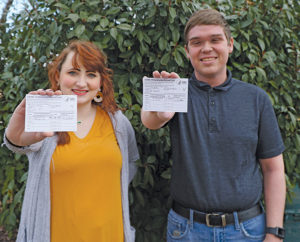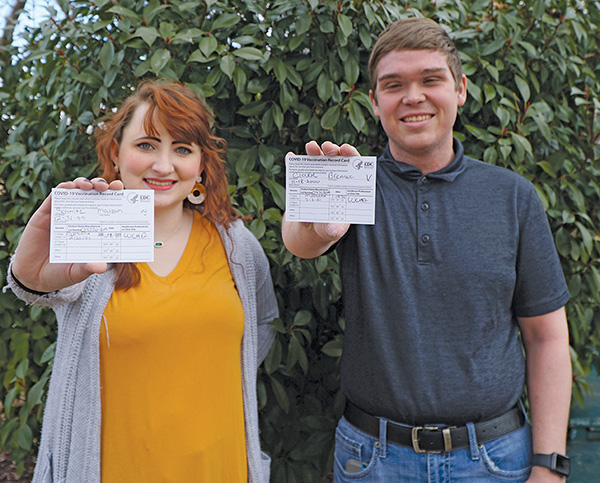By, JORDAN GREEN, Editor-in-Chief

Maleah Schmitz was sitting at home Jan. 18 when her phone rang.
A worker from the Woods County Health Department was calling to tell her that she could be immunized against COVID-19. But if she wanted the vaccine, she would have to be at the health department in 10 minutes.
“I had just woken up, so it was just like a huge rush to get there,” Schmitz said.
Schmitz, a junior general studies major at Northwestern, threw on some clothes and raced to her car, driving several blocks to the county health department’s building in downtown Alva.
She made it just in time. She parked her car in front of the building and walked inside. And when the nurse stuck the needle in Schmitz’s arm, Schmitz became one of the first students at Northwestern to be immunized against the coronavirus.
Since January 18, at least two Northwestern students have been vaccinated against COVID-19. Both students took the vaccine manufactured by Moderna, Inc., one of several companies racing to deliver a vaccine to people in the hopes of ending a months-long pandemic that has killed more than 400,000 Americans.
Across the nation, healthcare workers and government officials are rolling out plans to distribute vaccines to people who are more likely to develop serious health problems from contracting COVID-19. In Oklahoma, state leaders unveiled a multi-phase plan to administer the vaccines, with elderly people being first in line for inoculations.
Most Oklahomans may have to wait weeks or months to receive theirs. But under Oklahoma’s vaccine plan, healthcare workers are eligible to receive vaccines sooner than others.
Both students who got the vaccine work at Holder Drug, a pharmacy in Alva.
Schmitz learned she could take the vaccine after talking to Brenner Clark, a sophomore pre-nursing major who works with her at Holder Drug.
Clark found out pharmacy workers qualified to take the vaccine after visiting the Oklahoma State Health Department’s website.
“I believe part of it was because I work at Holder’s,” Clark said. “I think I also qualified because I have asthma.”
To get a vaccine, a person must meet certain age-related, occupational and health-related requirements, according to the state health department. The person must sign up to take the vaccine, with many Oklahomans doing so online.
Prospective shot-takers must answer a series of questions on the health department’s website when registering to take the vaccine.
After answering the questions, the person will find out whether he or she is eligible for the vaccination.
Once a person is eligible to take the vaccine, he or she must schedule an appointment to be immunized. But Clark wasn’t able to set one immediately.
“They had a little map that you could put your location in to see where you could get a vaccination and when you could get it,” he said. “But they didn’t have any appointments because they’re having a hard time getting everyone vaccinated.”
Confused, Clark left the website. A few days later, a health department nurse called him and told him he could be immunized Jan. 19 or Jan. 26.
He chose the former. He drove to the Alva Recreation Complex, where National Guard members were helping health department workers check patients’ registration information.
He walked into a room filled with nurses and Guard members. He answered questions nurses asked him and then went into a nearby room where nurses were administering the vaccine.
He rolled up his sleeve and took the shot. After he was immunized, doctors monitored his condition for 30 minutes to see whether he would experience any side effects. Then, doctors released him to return to school.
“That was it,” he said.
‘A LITTLE OUT OF IT’
Clark said he experienced some soreness and tiredness in the days following his vaccination.
“My arm hurt really bad for the first two days,” Clark said. “After a few days, it started wearing off. I didn’t really want to sleep on that side the night I got it. As it progressed a few days into it, I kind of started having a few headaches. And not really feeling sick, just kind of out of it. About the same as a flu shot, though.”
Four days after he was vaccinated, he told the Northwestern News most of his side effects were gone.
“My arm doesn’t hurt anymore,” he said Jan. 23. “I still get a couple of headaches, but it’s nothing I can’t manage with Ibuprofen. … It’s the first 24 to 48 hours getting through the shot that’s probably the worst.”
Aside from a few headaches, Schmitz said she didn’t have any issues in the days following her immunization.
“It is no different than a flu shot,” she said. “The whole experience of it and everything is really no different. The needle is the same size. Any pain that you have from the shot being put in is nothing. It’s a small pinch like any other shot. I felt no side effects. I felt a little out of it for a little bit, but that only lasted for about an hour. And that was about it.”
Both Clark and Schmitz will have to take a second dose of the vaccine in the coming weeks. The Moderna vaccine is administered in two phases, with one coming roughly a month after the other.
State health department officials reported Monday that more than 278,000 total coronavirus vaccine doses have been administered in Oklahoma.
Even though she was rushed, Schmitz said she’s glad she took the first dose when she did.
“I was like, ‘OK, this is it,’” she said. “This is one of my only chances I’m probably going to have. I’d rather not get the virus if I can avoid it.”

